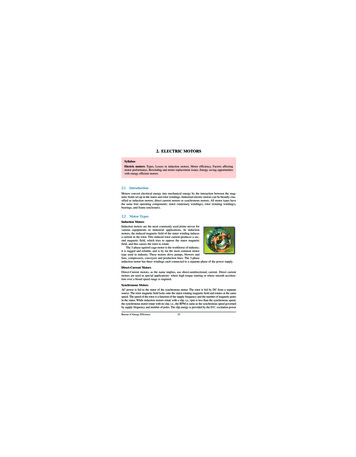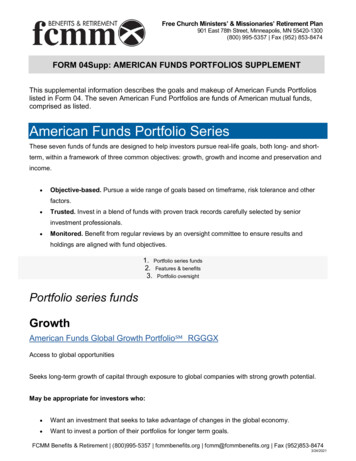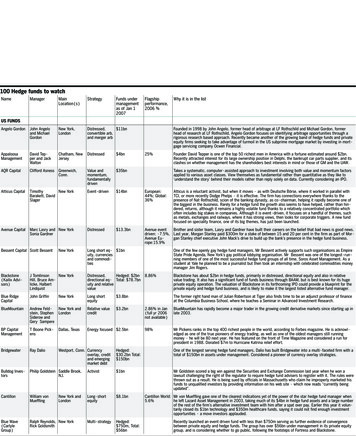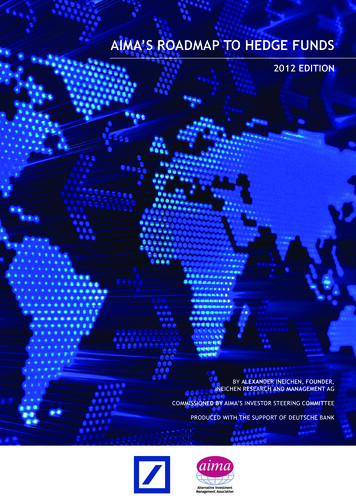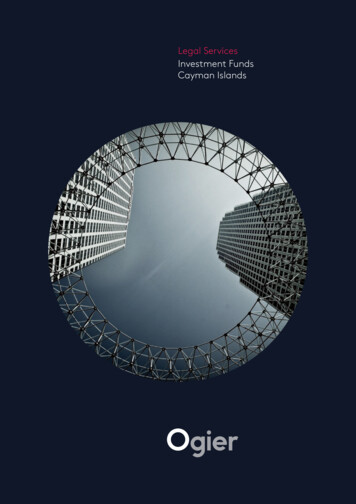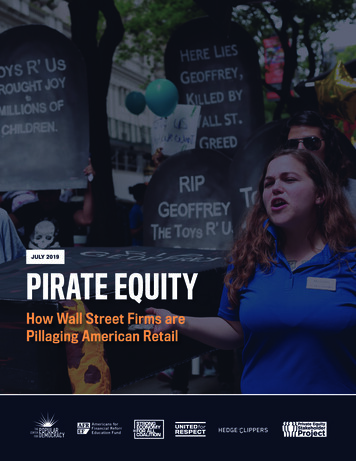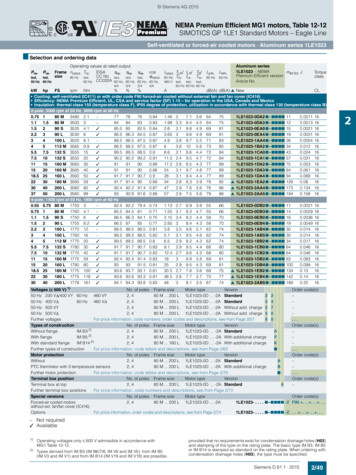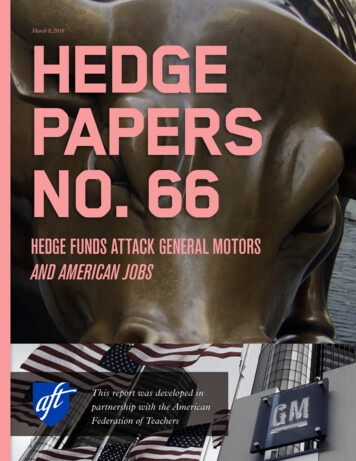
Transcription
March 8, 2018HEDGEPAPERSNo. 66HEDGE FUNDS ATTACK GENERAL MOTORSAND AMERICAN JOBSThis report was developed inpartnership with the AmericanFederation of Teachers
Hedge funds have become a destructive force in the American economyby exploiting regulatory loopholes that were meant to prevent the kind ofpredatory exploitation they’ve made into a profitable business model.Stock buybacks used to be illegal, and the American economy was strongerand more fair when they were.CONTENTS3 Introduction– Behind GM's Closures & Job Cuts– The Four-Year Campaign to Squeeze General Motors14 Meet the Billionaires Killing Jobs at General Motors– David Tepper, Appaloosa Management– David Einhorn, Greenlight Capital– J. Kyle Bass, Hayman Capital– Frank Brosens, Taconic Capital– Ravenel Boykin Curry IV, Eagle Capital Management20 Legislative Solutions– New laws could outlaw stock buybacks and hedge fund attacks on American jobs– Pension Fund & University Endowment Investments in Hedge Funds Attacking General Motors26 Who Are the Hedge Clippers27 Press General Inquiry ContactsThis report was developed in partnership with the American Federation of Teachers
INTRODUCTION
General Motors recently announcedlarge-scale plant closures and layoffs,with top executives claiming thecompany needs 4.5 billion in savingsto stay alive. This week the legendaryLordstown manufacturing plant inOhio will close.GM has given over five times as muchmoney— 25 billion—to Wall Streethedge funds and other investorsin the past four years, which includesover 10 billion in controversialstock buybacks.GM recently authorized even more stock buybacks:it’s possible that every single dollar “saved” fromjob cuts and plant closures will go straight into thepockets of hedge fund billionaires and Wall Street.In 2013, GM completed the taxpayer-funded bailoutthat kept the company alive and saved thousandsof American jobs.Billionaire hedge fund managers have been attackingthe company ever since.Hedge funds aren’t interested in American jobs, or inthe communities that will be hit by plant closures andjob loss.Hedge funds are only interested in short-term payoffsfor hedge funds and their billionaire managers —and they’ve relied on one-time dividends and sharebuybacks to get the cash they demand.Stock buybacks used to be illegal, and theAmerican economy was stronger and more fairwhen they were.March 8th, 2019 — Hedge Papers No. 664
Hedge funds have become a destructive forcein the American economy by exploiting regulatoryloopholes that were meant to prevent the kind ofpredatory exploitation they’ve made into a profitablebusiness model.Workers, families, communities and elected officialscan do something to fight back against the hedgefund attacks on GM and American jobs.It’s time to make stock buybacks illegal again.And it’s time to close the loopholes and putpredatory hedge funds out of business onceand for all.Stock buybacks usedto be illegal, andthe American economywas strongerand more fair whenthey were.March 8th, 2019 — Hedge Papers No. 665
BEHIND GENERAL MOTORSPLANT CLOSURES AND JOB CUTSJust days after Thanksgiving of 2018,General Motors announced that itwas closing five facilities, includingthe Lordstown assembly located justoutside Youngstown, Ohio.The Lordstown plant had been in operation sincethe 1960s, and is one of the major employers in theMahoning Valley.3The announcement of the Lordstownclosure was a devastating blow to theYoungstown area. The plant providedover 1,600 jobs and 250 million intotal wages in 2017 alone.Few pointed out the real culprits: activist hedge fundsdemanding that companies like GM turnover mostof their profits to Wall Street in the form of dividendsand stock buybacks.12Op-eds writers and talking heads were quick topoint fingers at deindustrialization, offshoring, and thecommercial failure of compact sedans.GM’s decision to close Lordstown was the culminationof a four-year campaign by hedge fund managers tosqueeze GM for every available dollar.Hedge fund investors repeatedly mounted pressurecampaigns to prevent GM from reinvesting theirprofits anywhere but back into their own share price.Through paid agents, harassing proxy measures, andpublic threats, the hedge funds extracted billions inbuybacks.And you don’t have to look back very far to see theimpetus for GM’s decision — just one month earlier,the hedge funds made a big public push for onemore sing-youngstown-ohio-autoworkers-jobs/576775March 8th, 2019 — Hedge Papers No. 666
GM’s decision to closeLordstown was theculmination of afour-year campaign byhedge fund managersto squeeze GM forevery available dollar.March 8th, 2019 — Hedge Papers No. 667
THE FOUR-YEAR CAMPAIGNTO SQUEEZE GMSHORT-TERM PUSH FORPAYOFFS HURTS GM ANDCOMMUNITIESIt was October 2018 and the hedge funds were pissed.4General Motors, the automotive giant, had completedits federal bailout just five years prior, repurchasing theremaining shares that the U.S. Government had boughtin 2009 under the Troubled Asset Relief Program.5Conservative estimates put the loss to taxpayersfrom the bailout at 10.5 billion dollars — more thanthe combined annual salary of all librarians in theUnited States.6Despite just being ten years from their bankruptcy —and the 51 billion taxpayer-funded bailoutthat rescued the company — General Motors hadstabilized and returned to profitability.GM had several highly profitable business lines andwas holding billions in cash — enough money toweather any future downturn and prevent anotherexpensive government bailout.But that fiscal prudence is exactly what angeredGM’s hedge fund investors.Hedge funds focus on short-term profits that benefitbillionaire hedge fund managers, period. Hedge fundattacks hurt the corporations and communities they’retargeting, and even many of the pensioners andworkers who provide the cash for hedge funds.7Last October, activist hedge funds demandedthat General Motors take their cash and carry out yetanother buyback of GM’s existing al-motors-tarp-bailout-exit-sale/3925515/ rstrange-corporate-governance-systemMarch 8th, 2019 — Hedge Papers No. 668
This would raise the stock value for existingshareholders, and for the hedge funds agitating for ashort-term payoff. But it wouldn’t do anything forthe long-term viability of GM as an ongoing enterprise.Stock buybacks hurt companies to benefit billionaires—- why are they even legal?This practice, called a share repurchase or stockbuyback, is controversial. And it used to be illegal.Stock buybacks can beused by hedge fundmanagers demandingcash in a kind ofprotection racket.For economists and long-term investors, stockbuybacks are bad moves that divert profits away frominnovation and investments in American workers.But even worse, stock buybacks can be used by hedgefund managers demanding cash in a more of anintimidation scheme than a normal business practice.If the company doesn’t pay the hedge funds the cash,the hedge funds start agitating, threatening to mountcostly proxy battles and sometimes waging negativePR campaigns.If a company like GM channels their profits to stockbuybacks, they can fend off the possibility of hostileproposals from hedge funds and other short-termprofit seekers.But only temporarily. The hedge funds always keepcoming back for more.March 8th, 2019 — Hedge Papers No. 669
HEDGE FUNDS ATTACKEDGM IMMEDIATELY AFTERTAXPAYERS BAILED IT OUTIn 2015, GM spent 5 billion buying back shares toplacate a hedge-fund led campaign for a short-termpayoff led by failed New York comptroller candidateHarry J. Wilson.8Wilson, who served on the government taskforcethat oversaw GM’s restructuring, owned a paltry 30,000shares in GM when he learned that the companyplanned to a one-year no buyback break.9Moody’s credit agency declared the buybacks to be a“negative credit development,” taking the position thatGM executives fretted about only months earlier.13And the 5 billion that evaporated from GM’s booksdid nothing productive for the company, its workers,consumers or the U.S. economy.HEDGE FUNDS KEPTDEMANDING CASH FROM GMIN SHORT-TERM PAYOUTSTwo years later, the hedge funds were at it again.This time David Einhorn, billionaire hedge fundmanager and school privatization cheerleader, hadtaken a long position in GM’s shares and was lookingfor a way to juice the share price so he could makea short-term profit.Despite his relatively small position in GM, Wilsonwas the face of a million-dollar hedge-fund-backedcampaign to get him elected to the GM board.10The hedge funds behind the effort includedAppaloosa Management (run by David Tepper, thebillionaire hedge fund manager who recentlypurchased the Carolina Panthers), Taconic Capital,Hayman Capital, and HG Vora Capital.11To ward off Wilson and his hedge fund backers, GMrelented and aspent 5 billion on share buybacks.12The 5 billion buyback was a boon for investors likethe hedge fund managers pulling Wilson’s strings,but not for GM.Einhorn, who owned 3.6% of GM’s common stock,proposed splitting the company’s stock into twoclasses, with one paying a fixed dividend and theothers appreciating with the remainder of thefirm’s earnings.14Einhorn claimed the plan would “unlock value” atGM, but as one of the largest shareholders, Einhorn’sGreenlight Capital stood to earn handsomely.8 0309856/gm-strikes-a-deal-with-harry-wilson9 d5e10 d5e GM wasn’t Wilson’s firsttime shilling for a billionaire in a fight with corporate management. Hedge fund billionaire and conducter of extremely thorough online duediligence Dan Loeb has used Wilson for two prior corporate shakedowns.11 tock-buyback/#18f8bfe841dd12 0309856/gm-strikes-a-deal-with-harry-wilson13 d-freeze-credit-rating-142376916714 0090266417002279/p17-1207 exhibit2.pdfMarch 8th, 2019 — Hedge Papers No. 6610
GM shareholders shot Einhorn’s proposal down,15 butGM CEO Mary Barra agreed to return 7 billion toWall Street shareholders “through buybacks anddividends,” selling off the company’s stake in its Opeland Vauxhall divisions in the process.16MOST RECENT HEDGE FUNDPUSH LED STRAIGHT TOPLANT CLOSURESWhich brings us back to October 2018—just a monthbefore the announcement of the Lordstown closure—where the hedge funds were circling GM yet again.John Levin, chair of Levin Capital Strategies, took toReuters to intone that “somebody” could be anglingfor a third shareholder campaign against thecompany, if more wasn’t done to compensate theshareholders.17Levin wasn’t alone—Reuters reporting also cited aDouglas C. Lane & Associates partner carpingabout how “frustrated” he was to own 2.57 millionGM shares.15 -2017-616 general-motors.html t-on-opelvauxhall-emissions/17 dUSKCN1MT2QMMarch 8th, 2019 — Hedge Papers No. 6611
By the end of 2018, GM seemed to have a solution: cutsto workers and communities to pay for all the moneyprovided to hedge fund billionaires.After wasting 25 billion on buybacks and dividends— including 10.6 billion in stock buybacks,the company vowed to shutter five facilitates for 4.5 billion in net savings.18Because GM management had previously authorizedan additional 5bn in stock buybacks, GM actuallyhas 4.4 billion in authorized share repurchases leftunrealized.19Every dollar ‘saved’ byplant closures and jobcuts at General Motorscould go straight into thepockets of Wall Street& billionaire hedge fundmanagers.That means that every dollar “saved” by plant closures andjob cuts at GM could go straight into the pockets ofWall Street and billionaire hedge fund managers.It remains to be seen whether all of the money GMis saving by shuttering these five facilities will go rightinto the pockets of hedge funds and othershareholders, or whether the company will reinvestany of that sum into General Motors.18 ressuring-gm-to-halt-14b-stock-buyback-plan/ l-save/ paid19 https://investor.gm.com/stock-informationMarch 8th, 2019 — Hedge Papers No. 6612
MEET THE BILLIONAIRESTHAT ARE KILLING JOBS AT GM
While workers, families andcommunities hit by plant closures atGM struggle, the billionairehedge fund managers who have beenattacking the company live inunbelievable luxury. They’re allmaking big bucks explodingeconomic inequality (and many areinvolved in other controversialbusiness maneuvers).the luxurious lives of the hedge fundmanagers are in stark contrast tothe economic misery they’ve inflictedon thousands of Americans in Ohio,Michigan and elsewhere.Massive mansions in Manhattan,the Hamptons, Florida and the“ hunt country” suburbs of New York,huge ranches in Texas, glitzy charityballs and pro football teams —March 8th, 2019 — Hedge Papers No. 6614
DAVID TEPPER,APPALOOSA MANAGEMENT 11.6 Billion Net Worth Multi-million-dollar homes in Floridaand the Hamptons Made big bucks from betting on the2008 financial collapse Tepper has a net worth of 11.6 billion. He madean estimated 1.5 billion in 2017 alone.20 Appaloosa has about 15 billion in assetsunder management Tepper recently bought the Carolina Panthers foran NFL record of 2.275 billion21 Tepper paid 43 million for Jon Corzine’sSagaponack oceanfront mansion in theHamptons22, which he promptly demolished andhad an even larger mansion constructed in itsplace that was completed last summer.23 Tepper also purchased a glamorous home inFlorida when he moved some of the offices of hishedge fund to Miami Beach24 While millions of Americans were reeling from thefallout of the 2008 financial crisis, Tepper actuallyprofited from it. His wealth increasedby nearly 500% from 2008-2015, thanks in largepart to a massive bet he made on the 2008financial collapse.25 Tepper has also been a cheerleader for schoolprivatization. He is the founder of New Jerseyeducation reform PAC “Better Education for Kids”26 He is also a board member of the Robin HoodFoundation, a charity that fights poverty through apolicy of “relentless http://www.espn.com/nfl/story/ ionaires-are-buying-homes-in-miami boosts-its-pitch25 6 ors/alan-fournier.html27 https://www.robinhood.org/about-us/governance/ vertyMarch 8th, 2019 — Hedge Papers No. 6615
DAVID EINHORN,GREENLIGHT CAPITAL 1.4 billion net worth Makes money from toxic polluters Massive mansion in “horse country” outsideNew York City 1.4 billion net worth Greenlight Capital has 5.5 billion in assets undermanagement Although he was once a high-flying hedge fundgoldenboy,32 2018 was a brutal year for Einhorn.His hedge fund lost 34.2%, its worst performancesince Einhorn started the firm in 1996.33 Greenlight is heavily invested in CONSOLCoal Resources, a segment of coal and gasexploration company CONSOL Energy Inc.As of their last SEC filing, Greenlight owned 47%of CONSOL Coal Resources, worth about 90million.34 Besides their fines for pollution, CONSOL is amember of an industry association called“American Coalition for Clean Coal Electricity”(ACCCE).28 The ACCCE was a major forcelobbying against the EPA’s updated Mercury andAir Toxics Standards,29 a major update toregulations on the toxic and carcinogenicemissions from power plants, which is currentlybeing challenged at the Supreme Court level.30According to the EPA, the challenged regulationswould tighten permissible emissions ofmethylmercury, a highly carcinogenic pollutantthat is a byproduct of coal-fired power.31 Until his recent divorce, Einhorn lived in a 10,000square foot home in Rye, New York.2829303132333435CONSOL Energy is a fossil fuel company with along history of environmental fines. In 2011, theEnvironmental Protection Agency reached a 5.5million settlement with CONSOL Energy, overallegations “that six Consol mines violatedpollution discharge limits in their Clean Water Actpermits hundreds of times over the last fouryears.”35 In addition to the 5.5 million fine for theviolations, CONSOL also committed 200 millionto pollution controls and wastewater treatmentefforts, designed to mitigate the damage theirmining operations had on West Virginiawaterways. Einhorn is also a school privatization cheerleader.He has contributed tens of thousands of dollarsto Democrats for Education r-toxics-standards-mats-2015-3 and ital-inc#tabholdings tab ment-plant-settle-cleanMarch 8th, 2019 — Hedge Papers No. 6616
J. KYLE BASS,HAYMAN CAPITAL Net worth is secret Keeps gold bricks and platinum barsat his desk 60 million Texas ranch Dallas-based hedge fund manager J. Kyle Bassis perhaps best known for his strategies targetingthe pharmaceutical industry A previous Hedge Clippers investigation notedthat Bass’s tactic of disputing the patents of drugstocks he is short-selling can result in evenhigher drug prices for everyday Americans soBass and other billionaires can get even richer.36 Bass made hundreds of millions of dollars bettingon the collapse of the U.S. housing market.37 Thatbet earned him the sobriquet “the man who soldthe world.”38 Earlier last year, Bass sold his Barefoot Ranch foran undisclosed sum. It had been previously listedfor 59.5 million. The ranch includes a 35,000square-foot lodge for entertaining with a golfcourse, boat house on a lake, shooting ranch,paintball course and equestrian center. Eachamenity at the ranch was built for entertainingresidents and guests.39 He keeps gold bricks and platinum bars in hisdesk at Hayman.40 Hayman Capital’s billionaire CEO J. Kyle Bassowned a 4,000 Texas acre ranch valued at nearly 100 ss/March 8th, 2019 — Hedge Papers No. 6617
FRANK BROSENS,TACONIC CAPITAL Net worth unknown Mansions in New York City and suburbs Vulture investor attacking Puerto Rico pushingsub-minimum wages Brosens was a Larry-Summers confidante42 anda one-time frontrunner to run the TARPprogram.43 Taconic Capital is one of the vulture fundsseeking to profit off of Puerto Rico’s debt crisisand calling for austerity so they can get paid.Taconic was one of a handful of hedge funds thatmade huge purchases of subordinated bonds justafter Hurricane Maria, hoping to profit from thechaos caused by the hurricane.44 Taconic hasmade an estimated 68 million off of their vultureactivity in Puerto Rico.45 In 2010, Brosens and his wife Deenie bought a 6million Sutton Place co-op from RupertMurdoch’s ex-wife.46 The co-op featured 10-footceilings, a marble bath, a wood-paneled libraryand views of the city. Frank and his wife Deenie recently sold their13,000 square foot Bedford, NY47 home for over 3 million. The house includes a tennis court andindoor v/DS/DocumentSearch/DocumentImageView?doc id info/63-east-field-drive—2March 8th, 2019 — Hedge Papers No. 6618
RAVENEL BOYKIN CURRY IV,EAGLE CAPITAL MANAGEMENT Net worth unknown Currently holding 20,538,994 GM shares,valued at 687,029,00051 Multi-million-dollar apartment on Central ParkSouth in Manhattan, glamorous Carribeanretreat in the Dominican Republic Boykin Curry is a major supporter of schoolprivatization. He is a founder of Democrats forEducation Reform and a former member ofthe Public Prep charter school network.52 He isthe Co-Chair of Education Reform Now53and a former director at of Betsy DeVos-backedAlliance for School Choice54 and AmericanFederation for Children55 Curry has an multi-million dollar apartment in theTrump Parc building at 106 Central Park South. The couple has their own residence at the beachclub, called Casa Guava. (See picture fromArchitectural Digest.) Curry and his wife Celerie Kemble own PlayaGrande Beach Club, a boutique hotel in theDominican Republic, where a three-bedroombungalow is 2,000 per night. The coupleoriginally envision the property as a “privateretreat reserved for their families, friends, andfriends of friends.”49 Investors in the projectinclude Charlie Rose, Fareed Zakaria, GeorgeSoros, and Mariska Hargitay.50 Curry is one of a handful of Wall Street titanswho aimed to remake New York State andaligned with Andrew Cuomo during his first runfor Governor. At the time, Curry told the NewYork Times, “A lot of hedge fund and financepeople in New York had decided state politicswas too dirty and focused on their philanthropy.I think there’s an awakening now that we can bea force in Albany, but we’ve got to play a toughergame than before.”56 They are developing a planned community in theDominican Republic that will provide weekendsuccor to investors like Fareed Zakaria, the editorof Newsweek International; Bronson Van Wyck,the event planner; Moby, the musician and teashop owner; and other wealthy bohemians with anappetite for current affairs and social causesserved up in a tropical paradise. Mr. Curry, a moneymanager and education reform advocate, and Ms.Kemble have been collecting folks like these in theirCentral Park South apartment for some years,building a quasi-liberal brain-and-money trust ”5749 away-opens-to-new-guests/#71abd1c05226 and kemble-dominican-republic-compound-article50 away-opens-to-new-guests/51 ment-llc#tabholdings tab link52 -education-ties/53 ations/203687838/201722779349301507/IRS99054 https://projects.propublica.org/nonprofits/display 990/522111508/2016 02 EO%2F52-2111508 990 20141255 https://projects.propublica.org/nonprofits/display 990/330627955/2016 02 EO%2F33-0627955 990O 20141256 ter.html57 ns-new-cheerleaders.htmlMarch 8th, 2019 — Hedge Papers No. 6619
LEGISLATIVE SOLUTIONS
NEW LAWS COULD OUTLAWSTOCK BUYBACKS AND HEDGE FUNDATTACKS ON AMERICAN JOBSThe practice of hedge funds mountingexpensive campaigns to forcecompanies into buybacks is a relativelyrecent phenomenon.SHOULD STOCK BUYBACKSEVEN BE LEGAL?According to the American Prospect’s WilliamLazonack, the practice accelerated in the 2000s when,“[a]rmed with their huge “war chests,” these new-stylecorporate predators use a corrupt proxy-votingsystem, “wolf pack” hook-ups with other hedge funds,and once-illegal engagement with managementto compel corporations to hand over profits that thehedge funds did nothing to create.”58The hedge funds that attacked GM did absolutelynothing to create the company’s profits — but they didhave a huge role in destroying the 1,600 jobs in theMahoning Valley. They also had a hand in vaporizingthe 48 million in tax revenue previously contributedby the Lordstown plant alone.5958 059 osure-of-its-lordstown-assembly-plantMarch 8th, 2019 — Hedge Papers No. 6621
And these losses of economic opportunity aren’t likelyto be contained to just the workers at GM — joblosses will likely ripple out from parts manufacturerswho supply the plant to service jobs that depend onthe salaries of those who work there.Stock buybacks are neither an inevitable norenduring feature of our economy — they used to beflat-out illegal. For the majority of the last century,buybacks were deemed to be illegal marketmanipulation.The ban lasted until 1982, when Ronald Regan’s SECinstituted a rule that allowed companies to legallyconduct stock buybacks.Progressive policy makers have recently revived callsto ban or restrict buybacks.Last year, U.S. Senator Tammy Baldwin introducedthe “Reward Work Act”60 which:Repeals the Securities and ExchangeCommission (SEC) 10b-18 rule that makes iteasier for corporations to buy back their stocks.Finalized in 1982, the rule shields companiesfrom manipulation charges when buying back theirstock on the open market. In 1981, the S&P 500spent approximately two percent of its profitson buybacks. Last year, those same companiesspent 59 percent on buybacks. Now thatexecutives are largely paid in stock, they havea direct incentive to boost prices.61Last month, Chuck Schumer and Bernie Sandersintroduced legislation that would bar companies fromconducting buybacks if they didn’t provide a 15 minimum wage for their employees, paid time off,and benefits.62The Sanders-Schumer bill is an attempt to reign in thewage gap, which is a result of both stagnating workerwages and ballooning income for the very wealthy,largely generated by “stock-based pay.”60 e-bill/260561 rd-work-act62 chumer-bernie-sanders.htmlMarch 8th, 2019 — Hedge Papers No. 6622
The wages of the average American are far from theonly thing to suffer at the hands of buyback-obsessedcorporate management and hedge fund managers.Companies also cut research and development,sacrificing long-term profitability for short-term gains.hedge fund “wolf packs” like those that attacked GM,and to crack down on hedge fund abuses.64This isn’t just the conclusion of left-leaningpolicymakers: Larry Fink, CEO of BlackRock, criticizedthis phenomenon in a 2015 letter to CEOs, urgingthem to reduce buybacks.Hedge funds are an artifact of history, anaccident created by loophole in the 1940Investment Company Act. It was massivelyexpanded in the 1996 National Securities MarketImprovement Act, when hedge funds got theirhands on institutional money from pension fundsand en
pockets of hedge fund billionaires and Wall Street. In 2013, GM completed the taxpayer-funded bailout that kept the company alive and saved thousands of American jobs. Billionaire hedge fund managers have been attacking the company ever sin
